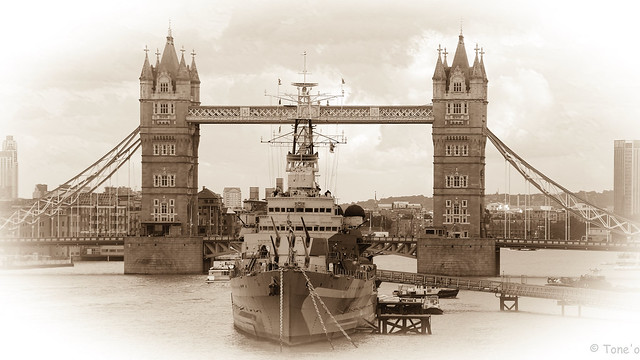Anybody want to buy a postcard? lol
London's Tower Bridge with H.M.S. Belfast in the foreground.
Taken from the top of a double decker bus crossing London Bridge. 2013.
(Wikipedia)
HMS Belfast is a Town-class light cruiser that was built for the Royal Navy. She is now permanently moored as a museum ship on the River Thames in London and is operated by the Imperial War Museum.
Construction of Belfast, the first ship in the Royal Navy to be named after the capital city of Northern Ireland and one of ten Town-class cruisers, began in December 1936. She was launched on St Patrick's Day 1938. Commissioned in early August 1939 shortly before the outbreak of the Second World War, Belfast was initially part of the British naval blockade against Germany. In November 1939, Belfast struck a German mine and, in spite of fears that she would be scrapped, spent more than two years undergoing extensive repairs. Belfast returned to action in November 1942 with improved firepower, radar equipment, and armour. Belfast saw action escorting Arctic convoys to the Soviet Union during 1943 and in December 1943 played an important role in the Battle of North Cape, assisting in the destruction of the German warship Scharnhorst. In June 1944, Belfast took part in Operation Overlord supporting the Normandy landings. In June 1945, she was redeployed to the Far East to join the British Pacific Fleet, arriving shortly before the end of the Second World War. Belfast saw further combat action in 1950–52 during the Korean War and underwent an extensive modernisation between 1956 and 1959. A number of further overseas commissions followed before she entered reserve in 1963.
In 1967, efforts were initiated to avert Belfast's expected scrapping and to preserve her as a museum ship. A joint committee of the Imperial War Museum, the National Maritime Museum, and the Ministry of Defence was established and then reported in June 1968 that preservation was practical. In 1971, however, the government decided against preservation, prompting the formation of the private HMS Belfast Trust to campaign for her preservation. The efforts of the Trust were successful, and the government transferred the ship to the Trust in July 1971. Brought to London, she was moored on the River Thames near Tower Bridge in the Pool of London. Opened to the public in October 1971, Belfast became a branch of the Imperial War Museum in 1978. Since 1973 she has been home to City of London Sea Cadets who meet on board twice a week. A popular tourist attraction, Belfast received over 327,000 visitors in 2019. As a branch of a national museum and part of the National Historic Fleet, Belfast is supported by the Department for Culture, Media and Sport, admissions income, and the museum's commercial activities...
Tower Bridge is a drawbridge in London. It crosses the River Thames near the Tower of London. It allows ships through the bridge deck when is raised at an angle in the centre.
The north side of the bridge is Tower Hill, and the south side of the bridge comes down into Bermondsey, an area in Southwark. Tower Bridge is far more visible than London Bridge, which people often mistake it for. Many tourists go to London to see the Tower Bridge. It has its own exhibition centre in the horizontal walkway. This gives one of the best vantage points in London.
The "bascules" are the surfaces raised to allow tall ships to pass through: this happens about 900 times per year. The bridge's decks (bascules) can be raised to 83o from the horizontal.
History-
The City of London Corporation held a competition for the design in 1876. Over 50 designs were entered, and in 1884 Horace Jones and John Wolfe Barry's design was chosen.
Workers began to build the Tower Bridge in April 1886 and the bridge was opened on 30 June 1894.
In June 2012, the bridge was highlighted on the route of Queen Elizabeth II's Diamond Jubilee Pageant on the Thames.
Design.
The bridge is 800 ft (244 m) in length with two towers, each 213 ft (65 m) high, built on piers. The central span of 200 ft (61 m) between the towers is split into two equal bascules or leaves, which can be raised to an angle of 83o to allow river traffic to pass. The bascules, weighing over 1,100 tons each, are counterbalanced to minimize the force required and allow raising in five minutes. The bascules are raised by huge hydraulic pumps which were first powered by steam engines. In 1976 these were replaced by oil and electricity. The bridge is made from more than 11,000 tons of steel, and covered with Cornish granite and Portland stone.
The two side-spans are suspension bridges, each 270 feet (82 m) long, with the suspension rods anchored both at the abutments and through rods contained within the bridge's upper walkways. The pedestrian walkways are 143 feet (44 m) above the river at high tide. These walkways allow people to still cross the river, even when the bridge is raised. They were closed in 1910 because not enough people used them, but were reopened in 1982.
 new
new

